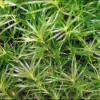Najas conferta
Scientific name: Najas conferta
Family: Najadaceae
Maximum size reached under cultivation: 50 - 100 cm (19.69 - 39.37 inch)
014
Recommended pH range: 6 - 7
Recommended water hardness: 2 - 12°dGH (35.71 - 214.29ppm)
0°C 32°F30°C 86°F
Recommended temperature range: 22 - 26 °C (71.6 - 78.8°F)
Preferred propagation method: Cuttings
Native to: South America
Growth rate: Fast
Recommended substrate: Fine gravel
Lighting requirements: Medium
Ideal placement in tank: Background
Origin
Native to Central and South America, specifically Brazil (Northeast, Southeast, West-Central), Cuba, Dominican Republic, and Panama.
Planting Area
Background; it can also be used as a floating plant for added versatility.
Propagation
This plant reproduces easily through cuttings. New stems can be clipped from any healthy section and either planted in fine gravel or allowed to float freely. The stems are fragile, so handle them gently. Planting several stems together in a bunch helps them stay upright and reduces stress from water movement.
Difficulty
Easy
Short Description
Najas conferta is a fast-growing, undemanding plant perfect for beginners and useful in a wide range of aquarium setups. It doesn't require special lighting or CO2, and thrives even under standard conditions. Its fine, bushy growth provides excellent shelter for fry and shrimp, making it especially valuable in breeding and community tanks.
FAQs
-
Can Najas conferta be used in breeding tanks?
Yes, it's excellent for breeding tanks. Its dense, fine foliage provides shelter for fry and reduces stress by offering cover. It also helps maintain good water quality by absorbing excess nutrients.
-
Does Najas conferta need to be planted in substrate?
No, it can thrive both rooted and floating. Many aquarists prefer to let it float, especially in tanks with delicate bottom substrates or to encourage surface-level cover.
-
How do I prevent Najas conferta from breaking apart?
Since the stems are very delicate, avoid strong water flow and handle with care during planting or maintenance. Grouping multiple stems together can also help them stay upright and support each other.
-
Can I trim this plant regularly?
Yes. Regular trimming helps manage its fast growth and encourages bushier, more compact form. Trim gently to avoid damaging the fragile stems.

 Najas guadaloupensis
Najas guadaloupensis